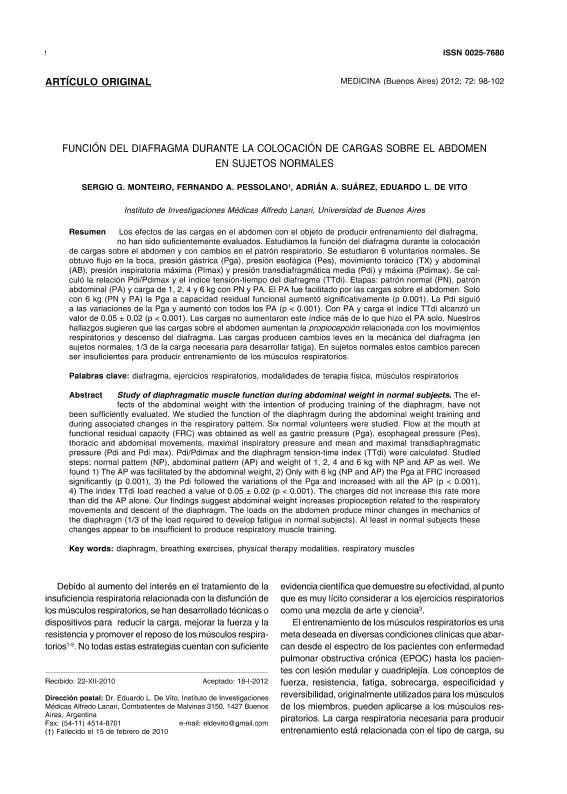Artículo
Los efectos de las cargas en el abdomen con el objeto de producir entrenamiento del diafragma, no han sido suficientemente evaluados. Estudiamos la función del diafragma durante la colocación de cargas sobre el abdomen y con cambios en el patrón respiratorio. Se estudiaron 6 voluntarios normales. Se obtuvo flujo en la boca, presión gástrica (Pga), presión esofágica (Pes), movimiento torácico (TX) y abdominal (AB), presión inspiratoria máxima (PImax) y presión transdiafragmática media (Pdi) y máxima (Pdimax). Se calculó la relación Pdi/Pdimax y el índice tensión-tiempo del diafragma (TTdi). Etapas: patrón normal (PN), patrón abdominal (PA) y carga de 1, 2, 4 y 6 kg con PN y PA. El PA fue facilitado por las cargas sobre el abdomen. Solo con 6 kg (PN y PA) la Pga a capacidad residual funcional aumentó significativamente (p 0.001). La Pdi siguió a las variaciones de la Pga y aumentó con todos los PA (p < 0.001). Con PA y carga el índice TTdi alcanzó un valor de 0.05 ± 0.02 (p < 0.001). Las cargas no aumentaron este índice más de lo que hizo el PA solo. Nuestros hallazgos sugieren que las cargas sobre el abdomen aumentan la propiocepción relacionada con los movimientos respiratorios y descenso del diafragma. Las cargas producen cambios leves en la mecánica del diafragma (en sujetos normales, 1/3 de la carga necesaria para desarrollar fatiga). En sujetos normales estos cambios parecen ser insuficientes para producir entrenamiento de los músculos respiratorios. The effects of the abdominal weight with the intention of producing training of the diaphragm, have not been sufficiently evaluated. We studied the function of the diaphragm during the abdominal weight training and during associated changes in the respiratory pattern. Six normal volunteers were studied. Flow at the mouth at functional residual capacity (FRC) was obtained as well as gastric pressure (Pga), esophageal pressure (Pes), thoracic and abdominal movements, maximal inspiratory pressure and mean and maximal transdiaphragmatic pressure (Pdi and Pdi max). Pdi/Pdimax and the diaphragm tension-time index (TTdi) were calculated. Studied steps: normal pattern (NP), abdominal pattern (AP) and weight of 1, 2, 4 and 6 kg with NP and AP as well. We found 1) The AP was facilitated by the abdominal weight, 2) Only with 6 kg (NP and AP) the Pga at FRC increased significantly (p 0.001), 3) the Pdi followed the variations of the Pga and increased with all the AP (p < 0.001), 4) The index TTdi load reached a value of 0.05 ± 0.02 (p < 0.001). The charges did not increase this rate more than did the AP alone. Our findings suggest abdominal weight increases propioception related to the respiratory movements and descent of the diaphragm. The loads on the abdomen produce minor changes in mechanics of the diaphragm (1/3 of the load required to develop fatigue in normal subjects). Al least in normal subjects these changes appear to be insufficient to produce respiratory muscle training.
Función del diafragma durante la colocación de cargas sobre el abdomen en sujetos normales
Título:
Study of diaphragmatic muscle function during abdominal weight in normal subjects
Fecha de publicación:
04/2012
Editorial:
Fundación Revista Medicina
Revista:
Medicina (Buenos Aires)
ISSN:
0025-7680
Idioma:
Español
Tipo de recurso:
Artículo publicado
Clasificación temática:
Resumen
Archivos asociados
Licencia
Identificadores
Colecciones
Articulos(OCA HOUSSAY)
Articulos de OFICINA DE COORDINACION ADMINISTRATIVA HOUSSAY
Articulos de OFICINA DE COORDINACION ADMINISTRATIVA HOUSSAY
Citación
Monteiro, Sergio G.; Pessolano, Fernando A.; Suarez, Adrián A.; de Vito, Eduardo; Función del diafragma durante la colocación de cargas sobre el abdomen en sujetos normales; Fundación Revista Medicina; Medicina (Buenos Aires); 72; 2; 4-2012; 98-102
Compartir




